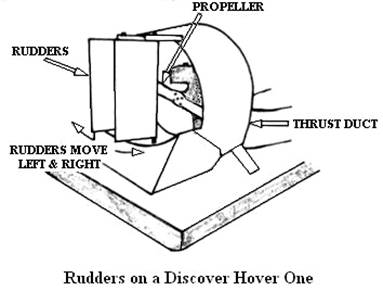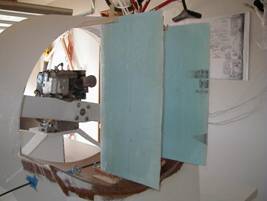
Sketch by J. Benini
| NAME |
|
When driving a car, friction of the rubber tires on the road allows almost instant change in direction when the steering wheel is turned. Piloting a hovercraft, however, is like driving a wet bar of soap, partly because you slide over most surfaces with little friction. Because ground contact friction is limited, they are easily affected by wind and surface slope. To maintain directional control of a conventional hovercraft, rudders at the rear of the craft are used to direct the flow of thrust air from the propeller. This causes a change in the directional force of the thrust air, which will turn the rear of the craft either left or right. Initially, when the rudders are turned the body of the hovercraft turns, but maintains the same direction of travel. Remember from Newton’s first law that objects in motion tend to stay in motion, so even when the rudders are turned, the hovercraft will want to continue traveling in the old direction. Gradually, the new thrust direction overcomes the momentum of the hovercraft and the direction of travel changes.

Sketch by
J. Benini
The more thrust air you can redirect, the faster the hovercraft will respond
to directional changes. This is why hovercraft usually have at least 2 rudders.
Some models may have as many as 5 rudders to change the direction of nearly
all the thrust air. To be effective at low speeds, rudders must also turn at
least 60 degrees in each direction. Rudders are usually shaped like a symmetrical
airfoil to minimize drag (air resistance) and to maintain smooth airflow as
the angle increases.

Sketch by
J. Benini
In the above diagram you can see how the rudders cause the hovercraft to turn.
By redirecting the flow of air in one direction, the air pushes back on the
rudders (Newton’s third law). The rudders, as well as the entire backside
of the hovercraft, turn. The hovercraft rotates so that it is heading in a new
direction.
On many light hovercraft, such as the Discover Hover One, you can also turn
the hovercraft by leaning in that direction. If you shift all your body weight
to one side, you can cause the skirt and edge of the hull on that side to drag
along the ground. This added friction will cause the hovercraft to turn. Combining
this with the rudders can lead to sharper turns!

